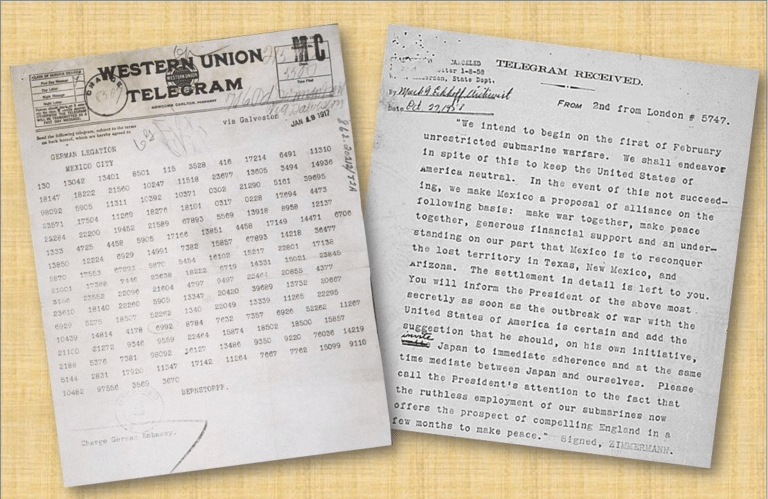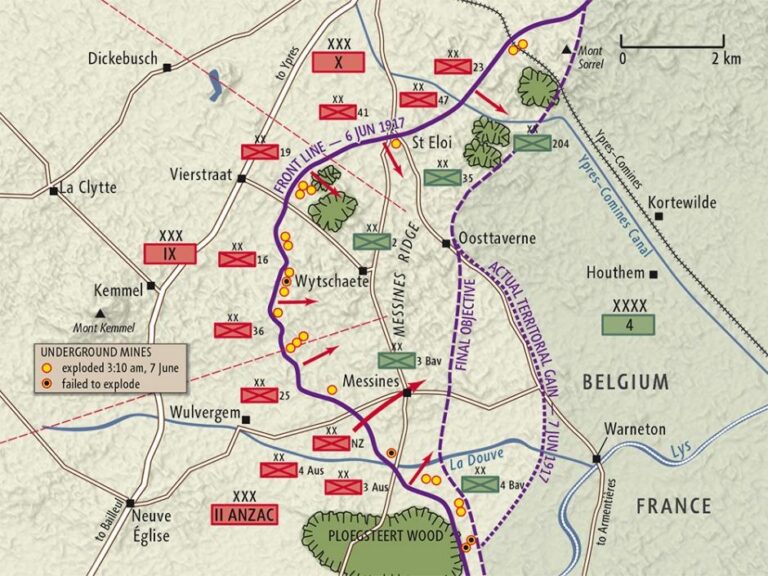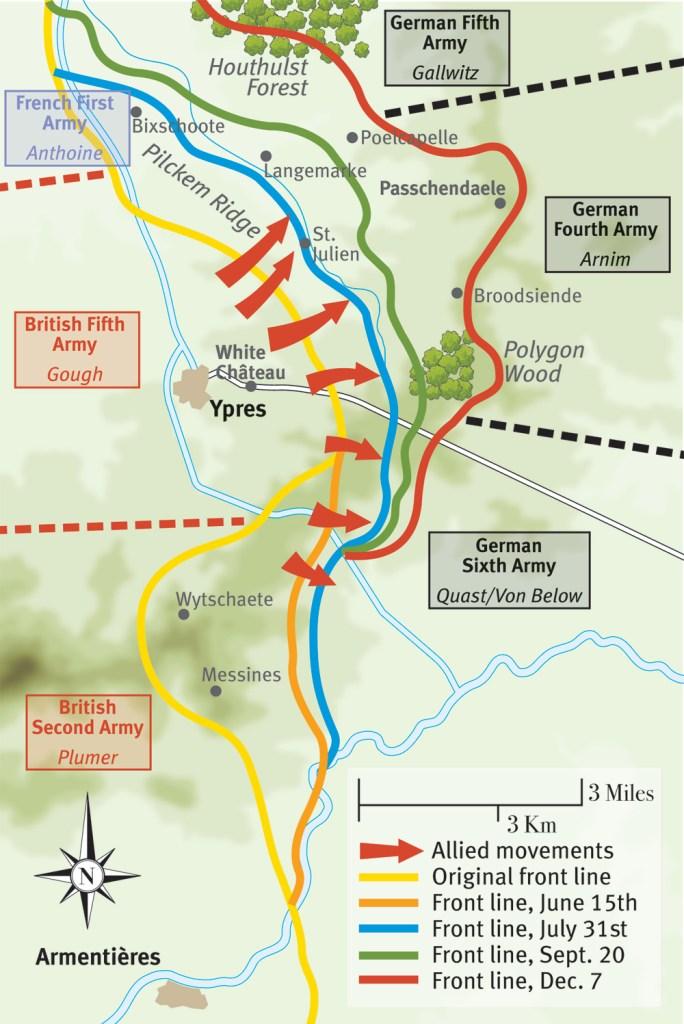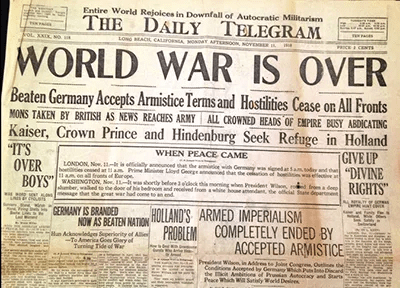World War I, also known as the Great War, was an international struggle that engulfed more than 100 nations in the world, including the majority of European countries, between 1914 and 1918. The war was fought between the Allies or Entente Powers (primarily France, Great Britain, Russia, Italy, and, from 1917, the United States) and the Central Powers (primarily Germany, Austria-Hungary, Bulgaria, and the Ottoman Empire). Officially, Germany was mostly to blame for the war’s four years of unimaginable carnage. But several complex reasons, including a gruesome assassination, contributed to the war.
The Battle of Dogger Bank (24th January 1915):
This is the first major confrontation between British and German ships in WWI fought near Dogger Bank in the North Sea. This resulted in a British victory and the German navy postponed taking any further substantial action against the British fleet for more than a year.

The Battle of Gallipoli (19th February 1915 to 9th January 1916):
The Battle of Gallipoli was fought in an attempt to knock the Ottoman Empire out of the war. The original idea was battleships forcing their way through the Dardanelles and launching an attack on Constantinople. After this proved unfeasible, the Allies decided to send troops to the Gallipoli Peninsula to widen the straits.
Due to poor management, the Allied forces were essentially imprisoned in their beachheads and they finally started withdrawal at the end of the year. This represented the Ottoman Empire’s greatest triumph of the war.

Italy Joining the War:
Italy stayed neutral during the start of the war despite being a signatory to the Triple Alliance with Germany and Austria-Hungary. Despite being prodded by its allies, Italy argued that the alliance was defensive in nature and that since Austria-Hungary was the aggressor it did not apply.
Italy carefully examined its options over the following months, weighing how to benefit the most from the conflict while being courted by both sides. Finally, Italy joined the Allies after signing the treaty of London in April 1915, which fulfilled its national dream of control over territory on its border with Austria-Hungary stretching from Trentino through South Tyrol to Trieste. The Allies also offered territory from the Ottoman Empire, the Albanian port city of Vlorë, and a central protectorate in Albania. They also promised the Italians a portion of Dalmatia and numerous islands along Austria-Hungary’s Adriatic coast.
On 23rd May 1915, Italy declared war on Austria-Hungary. They declared war on Germany the following year.
The Second Battle of Ypres (22nd April to 25th May 1915):
The Germans made their first use of poison gas on the Western Front during this battle. Although the Germans initially had an advantage with this new technology, they were ultimately defeated after fierce combat. Despite not making a breakthrough, the Germans were able to place the strategic town of Ypres inside their artillery’s range.

The Sinking of the Lusitania:
British ocean liner RMS Lusitania was torpedoed and sunk by a German U-boat on 7th May 1915 as it was sailing from New York City to Liverpool, England. This strike resulted in the deaths of over 1100 civilians, including more than 120 Americans. This pivotal event ultimately proved to be one of the catalysts that persuaded American public opinion to shift from its previous posture of neutrality to being a participant in WWI.

The Battle of Loos (25th September to 14th October 1915):
British and French forces planned coordinated attacks in Artois and Champagne to put an end to trench warfare and resume a war of movement. The British Army used a huge amount of poison gas for the first time during the attack on 25th September.
The Battle of Loos saw the British scoring some successes but at a very heavy cost. The British suffered roughly twice as many casualties as the Germans when the battle concluded in the middle of October.

Battle of Verdun (21st February to 18th December 1916):
It was the longest and largest battle fought on the Western Front during the conflict. German forces made an effort to take the high ground surrounding Verdun while luring the French reserves into a battle of destruction. They made some early progress, but as the French resistance grew and reinforcements poured in, the battle evolved into a grueling, terrible conflict.
Fighting persisted throughout the summer, and in August the French started launching counterattacks. Within October, France regained most of the territory the Germans had earlier in the year. The Battle of Verdun soon became an iconic symbol of the French resolve to defend their country.

The Battle of Jutland (31st May to 1st June 1916):
The Grand Fleet of the Royal Navy of Great Britain and the High Seas Fleet of the Imperial German Navy engaged in the largest naval battle and the only full-scale clash of battleships during the Battle of Jutland. The conflict took place off Denmark’s Jutland Peninsula in three major battle engagements (the battle cruiser action, the fleet action, and the night combat).
As the German naval force was insufficient to openly attack the whole British fleet, they sought to lure out, trap, and destroy a portion of the British Grand Fleet. The British force also responded with early warning intelligence from its code-breaking section.
The British sustained greater losses than the Germans in both ships and men. Yet it reinforced British naval superiority and cemented its control of shipping lines. This allowed Britain to enact the blockade that would eventually lead to Germany’s defeat in 1918.

The Battle of The Somme (1st July to 18th November 1916):
British and French forces worked together in the Battle of the Somme against the Germans on the Western Front, which turned into one of the most bitter, deadly, and costly battles ever.
This battle is also marked by the first-ever appearance of Tanks (Mark I by Britain) on the battlefield. Since the tanks were still in the early stages of development, several of them malfunctioned before reaching the front lines.
The battle caused severe damage to German positions in France and they strategically withdrew to the Hindenburg Line in March 1917 rather than engage in further fighting over the same territory in the spring.

The Battle of Romani (3rd to 5th August 1916):
The Ottoman Empire launched its third and final attempt in August 1916 to block the Suez Canal, Britain’s crucial supply route to its eastern Empire. At Romani, their attacking force was caught in a strategically placed British trap and they were forced to retreat.
The Battle of Romani marked the British Empire’s first significant mounted and infantry victory in WWI. It finally secured British control of the Suez Canal, and the Sinai Desert and opened the road to Palestine.

The Italian Front in 1916:
Austria-Hungary launched a “punishment” attack on 15th May by attacking through the Trentino mountains in retaliation for Italy’s alleged breach of its Triple Alliance obligations. The Austrians first overpowered the defenders when they attacked between Lake Garda and the headwaters of the River Brenta. After recovering, the Italians mounted a valiant resistance that put an end to the onslaught.
Despite its setbacks in the Trentino, Italy continued to plot further assaults in the valley of the Isonzo River. They seized Gorizia to begin the Sixth Battle of the Isonzo in August. In September, October, and November, the seventh, eighth, and ninth battles took place but made little progress.

Russian Offensives on the Eastern Front in 1916:
The first assaults started on 18th March in response to French requests to relieve pressure on Verdun. The Russians attempted to retake the town of Vilna in Eastern Poland by attacking the Germans from both sides of Lake Naroch. They made some success while moving forward on a constrained front before the Germans launched a counterattack. The Russians conceded defeat following 13 days of battle.
In the wake of failure, Russia planned an operation in Austria. Using new tactics, they attacked with a wide front and overwhelmed the Austrian defenders. Inspired by this success, they attacked Germany and got defeated once again. However, the offensives continued in Austria till September. After advancing sixty miles, it ended due to a lack of reserves and the need to aid Romania.
Romania’s Entry into War in 1916:
The desire to expand its frontiers by incorporating Transylvania motivated Romania, previously neutral, to side with the Allies. Despite considerable victories during the Second Balkan War, the nation’s military was weak, and it faced threats from all three sides.
On 27th August 1916, Romanian forces made a war declaration and moved into Transylvania. German and Austrian soldiers launched a counteroffensive in response, while the Bulgarians to the south also launched attacks. The Romanians were quickly outnumbered and forced to flee to Moldavia, abandoning Bucharest (capital city) on 5th December, where they dug in with help from Russia.

The Zimmermann Telegram and The Official Entry of The USA to WWI (12th January to 6th April 1917):
The Zimmermann Telegram was a diplomatic communication from the German Foreign Office to Mexico on 12th January 1917 that suggested a military alliance between the two countries if the United States joined the Allies in the War. Mexico was assured of financial assistance to reclaim the territory lost (Texas, Arizona, and New Mexico) during the Mexican-American War.
The British intercepted and decrypted the Zimmermann Telegram, and they then gave it to the Americans. At first, some people thought the telegraph might have been fake to force America into the conflict. To put an end to any lingering doubts, Zimmermann, in a speech delivered in the Reichstag on 29th March 1917, confirmed the telegram’s authenticity.
The Zimmermann Telegram helped turn the U.S. public, already angered by repeated German attacks on U.S. ships, firmly against Germany. On April 2, President Wilson, who had initially sought a peaceful resolution to World War I, urged immediate U.S. entrance into the war. Four days later, Congress formally declared war against Germany.
The Zimmermann Telegram strengthened the public’s animosity toward Germany, which had already been stoked by a series of German attacks on American ships. With the majority voting in favor of the war in the Senate and House of Representatives, the USA officially declared war on Germany on 6th April 1917.

The Battle of Arras (9th April to 16th May 1917):
The Battle of Arras was a major British offensive during WWI in which they achieved the longest advance since trench warfare had begun. For supporting the French Army’s attack on the Aisne front, The British and their Commonwealth Allies took part in a diversionary operation that stretched from Vimy in the north to Bullecourt in the south.
This combined operation aimed to end the war in 48 hours. However, ultimately it became a costly stalemate for both sides.

The Battle of Messines (7th to 14th June 1917):
The Battle of Messines was a prelude to the much larger Third Battle of Ypres − better known as Passchendaele. The attack was aimed at the Messines Ridge, a German salient since late 1914 and a natural bastion southeast of Ypres. It forced the Germans to move reserves to Flanders from the Arras and Aisne fronts, relieving pressure on the French after their failed Aisne front offensive.

The Battle of Passchendaele or Third Battle of Ypres (31st July to 6th November 1917):
This battle served as a vivid symbol of the mud, madness, and senseless slaughter of the Western Front. Passchendaele, the third and longest battle to occur in the Belgian city of Ypres, was an Allied success, although it was obtained at great expense for a piece of ground that would be relinquished the following year.

The Battle of Caporetto or 12th Battle of the Isonzo (24th October to 19th December 1917):
In the Battle of Caporetto, a combined German and Austro-Hungarian force achieved one of the war’s most crushing triumphs by annihilating the Italian line along the northern Isonzo River, which had been stalemated for two and a half years.

The Battle of Cambrai (20th November to 6th December 1917):
The Battle of Cambrai, a British advance on the Western Front, saw the first widespread and successful application of tanks in combat. Attacking by complete surprise on 20th November, the British tanks ripped through German defenses and made an advancement of 5 miles, an achievement not seen since the early stages of the war. However, due to inclement weather and a shortage of reinforcements, the offensive was put on hold.
The German Army launched a counterattack on 30th November and by 5th December, the British had been forced back. Both sides were worn out by the end of the battle on 6th December.

The Russian Revolution and Withdrawal from the War (March 1918):
WWI proved to be the death knell of the Tsarist regime in Russia. Russian infrastructure proved to be insufficient for Total War, resulting in severe food shortages, inflation, and the breakdown of the transportation system, which were made worse by the central government’s inability to effectively manage anything.
1917 saw Russia shaken by two significant power grabs. The Tsar of Russia was first overthrown in February by two concurrent revolutionary governments, one primarily liberal and one socialist. However, after some confusion, a fringe socialist group led by Lenin overthrew the coexisting revolutionary governments in October, creating the first socialist state in history.
On 3rd March 1918, Russia signed a treaty with the Central Powers ending its involvement in WWI in the city of Brest-Litovsk in modern-day Belarus.

Mobilization of the US Army in Europe (March 1918):
Although the United States entered the war in April 1917, it took some time to mobilize the troops and retool its industry for war. Only 3.18 lac Americans had entered France by March 1918. Through the summer, this figure started to rise quickly, and by August, 13 lac soldiers had been sent abroad.
The Spring Offensives (21st March to 18th July 1918):
Germany was able to move a sizable number of troops from the Eastern Front to the west after Russia’s capitulation. Germany started preparing a series of offensives to quickly end the war on the Western Front because it was aware that an increasing number of American troops would soon offset the numerical advantage it had achieved. The 1918 Spring Offensives, also known as the Kaiser’s Battle, were to include four significant assaults with the codenames Michael, Georgette, Blücher-Yorck, Gneisenau, and Marneschutz-Reims.
Operation Michael started on 21st March and by its end on 5th April, the Germans had captured 3,100 square kilometers of land and taken 90 thousand of prisoners. However, operationally the offensive was a failure as nothing of importance was taken by the Germans, and neither the British army nor its relationship with its French partner was destroyed.
Operation Georgette, a second onslaught aimed at seizing Hazebrouck, began on 9th April. Despite making swift progress, the Germans were unable to capture the rail center.
Operation Blücher started on 27th May, which saw German troops advance to within 90 kilometers of Paris. However, they formed a weak salient than inflicting any serious harm on their adversaries.
Operation Gneisenau on 9th June was inconclusive and the final offensive (Marneschutz-Reims) on 15th July was a total failure. Later The tired Germans were struck by a surprise French-led offensive on 18th July.
Due to this disaster, the German force was left terminally weak, disheartened, and facing an impending and unavoidable defeat at the hands of an Allied counteroffensive.

The Second Battle of the Marne (15th July to 6th August 1918):
The offensive along the Marne turned out to be the last the German Army would mount in the war. It was intended to lure Allied forces south from Flanders to aid an attack in that area. However, with the intelligence gathering, the Allies planned a powerful counteroffensive.
On 18th July, they moved forward and quickly shattered German opposition. Following 2 days of combat, the Germans started to retreat to their lines between the Aisne and Vesle Rivers. This Allied assault was the first in a string of persistent offensives that would ultimately conclude the war in November.

The Battle of Amiens (8th to 11th August 1918):
It was the start of the “Hundred Days”, a series of Allied Force offensive victories on the Western Front that caused the German army to crumble and bring about the conclusion of the war.

The Battle of Megiddo (19th to 25th September 1918):
It was the final battle of the First World War’s Sinai and Palestine campaign. Armies from the British Empire and France surrounded German and Ottoman forces. In addition to the infantry assault, the Allied Force cut off the key supply and reinforcement routes.
Within 24 hours, the mounted forces traveled more than 50 kilometers into Turkey’s hinterland. The Turkish army quickly crumbled after this battle, which allowed the Allied Forces to push on Damascus quickly.
The Battle of Vittorio Veneto (24th October to 4th November 1918):
It was the final Italian offensive of WWI. The multinational Hapsburg Empire split up internally as a result of this Italian invasion. The defeat of the Austro-Hungarian army ended the centuries-old empire and radically altered the political landscape of central Europe.

The Meuse-Argonne Offensive (26th September to 11th November):
The Meuse-Argonne Offensive was one of the final campaigns of WWI. Being part of the “Hundred Days” offensives, this was the biggest American operation of the war. Despite early victories for the First US Army, the campaign quickly turned into a brutal war of attrition.
The German and Austro-Hungarian Collapse:
The German and Austro-Hungarian armies both fell apart in October 1918 as a result of famine and fatigue from the war. When President Woodrow Wilson released Point 10 of his Fourteen Points, regarding the subject peoples of the Empire, the Austro-Hungarian monarchy lost any remaining support among its multicultural population. The Dual Monarchy’s fall resulted in the creation of new states. The German army’s defeat on the battlefield in 1918 also resulted in significant changes to its governance. The two Great Powers of Central Europe were thus defeated.
End of the War:
At the 11th hour on the 11th day of the 11th month of 1918, the Great War finally ended. Germany signed an armistice deal with the Allies on a train car outside of Compiégne, France.
The war ended with an armistice, an agreement in which both sides agree to stop fighting, rather than surrender. For both sides, it was the fastest way to end the war’s misery and carnage.




